Water and Nitrogen Coupling Increased the Water-Nitrogen Use Efficiency of Oilseed Flax
Abstract
:1. Introduction
2. Results
2.1. Weather Conditions
2.2. Variance Analysis of GY, Water, and N Utilization-Related Traits
2.3. Water Storage Efficiency and Soil Water Storage
2.4. Biomass, Grain Yield and Yield Components
2.5. Water Consumption, Water and Nitrogen-Use Efficiency
3. Discussion
4. Materials and Methods
4.1. Experimental Site
4.2. Experimental Design
4.3. Measurement and Calculation
4.4. Statistical Analyses
5. Conclusions
Author Contributions
Funding
Institutional Review Board Statement
Informed Consent Statement
Data Availability Statement
Acknowledgments
Conflicts of Interest
References
- Cattivelli, L.; Rizza, F.; Badeck, E.; Mazzucotelli, E.; Mastrangelo, A.M.; Francia, E.; Mare, C.; Tondelli, A.; Stanca, M. Drought tolerance improvement in crop plants: An integrated view from breeding to genomics. Field Crop Res. 2008, 105, 1–14. [Google Scholar] [CrossRef]
- Li, C.J.; Xiong, Y.W.; Cui, Z.; Huang, Q.Z.; Xu, X.; Han, W.G.; Huang, G.H. Effect of irrigation and fertilization regimes on grain yield, water and nitrogen productivity of mulching cultivated maize (Zea mays L) in the Hetao Irrigation District of China. Agric. Water Manag. 2020, 232, 106065. [Google Scholar] [CrossRef]
- Available online: https://baijiahao.baidu.com/s?id=1720631594400673812&wfr=spider&for=pc (accessed on 1 December 2022).
- Zhang, J.P.; Xie, Y.P.; Dang, Z.; Wang, L.M.; Li, W.J.; Zhao, W.; Zhao, L.; Dang, Z.H. Oil Content and Fatty Acid Components of Oilseed Flax under Different Environments in China. Agron. J. 2016, 108, 365–372. [Google Scholar] [CrossRef]
- Turin, E.N.; Susskiy, A.N.; Stukalov, R.S.; Shestopalov, M.V.; Turina, E.L.; Ivanov, V.I.U. Linum usitatisimum L. is the most important crop in Russia for the production of high-quality oil with low cost (review). IOP Conf. Ser. Earth Environ. Sci. 2021, 640, 042014. [Google Scholar] [CrossRef]
- Cui, Z.J.; Yan, B.; Gao, Y.H.; Wu, B.; Wang, Y.F.; Wang, H.D.; Xu, P.; Zhao, B.Q.; Cao, Z.; Zhang, Y.; et al. Agronomic cultivation measures on productivity of oilseed flax: A review. Oil Crop Sci. 2022, 7, 53–62. [Google Scholar] [CrossRef]
- Available online: https://m.chyxx.com/industry/202101/922216.html (accessed on 1 December 2022).
- Lafond, G.P.; Irvine, B.; Johnston, A.M.; May, W.E.; McAndrew, D.W.; Shirtliffe, S.J.; Stevenson, F.C. Impact of agronomic factors on seed yield formation and quality in flax. Can. J. Plant Sci. 2008, 88, 485–500. [Google Scholar] [CrossRef]
- Xia, G.; Wang, Y.; Hu, J.; Wang, S.; Zhang, Y.; Wu, Q.; Chi, D. Effects of supplemental irrigation on water and nitrogen use, yield, and kernel quality of Peanut under Nitrogen-Supplied Conditions. Agric. Water Manag. 2021, 243, 106518. [Google Scholar] [CrossRef]
- Tian, Y.Q.; Feng, L.P.; Zou, H.P.; Zhang, Z.J.; Miao, Y.X. Effects of water and nitrogen on growth, development and yield of rice in coldarea of Northeast China. Acta Ecol. Sin. 2014, 34, 6864–6871. [Google Scholar]
- Wang, L.L.; Jairo, A.P.; Chen, W.; Chen, Y.L.; Deng, X.P. Nitrogen fertilization improved water-use efficiency of winter wheat through increasing water use during vegetative rather than grain filling. Agric. Water Manag. 2018, 197, 41–53. [Google Scholar] [CrossRef]
- Liu, R.X.; He, J.Z.; Zhang, L.M. Response of nitrification/denitrification and their associated microbes to soil moisture change in paddy soil. Environ. Sci. 2014, 35, 4275–4283. [Google Scholar]
- Liu, R.; Yang, Y.; Wang, Y.S.; Wang, X.C.; Rengel, Z.; Zhang, W.J.; Shu, L.Z. Alternate partial root-zone drip irrigation with nitrogen fertigation promoted tomato growth, water and fertilizer-nitrogen use efficiency. Agric. Water Manag. 2020, 233, 106049. [Google Scholar] [CrossRef]
- Osman, C.; Gur, M.A.; Mehmet, K.; Ufuk, D. Determination of correlation and path analysis among yield components and seed yield in oil flax varieties (Linum sitatissimum L.). J. Biol. Sci. 2006, 6, 738–743. [Google Scholar]
- Darapuneni, M.K.; Morgan, G.D.; Ibrahim, A.; Duncan, R.W. Association of flax seed yield and its components in southeast texas using path coefficient and biplot analyses. J. Crop Improv. 2014, 28, 1–16. [Google Scholar] [CrossRef]
- Zhang, Q.X.; Gao, Y.H.; Yan, B.; Cui, Z.J.; Wu, B.; Yang, K.; Ma, J. Perspective on oil flax yield and dry biomass with reduced nitrogen supply. Oil Crop Sci. 2020, 5, 69–73. [Google Scholar] [CrossRef]
- Zare, S.; Mirlohi, A.; Saeidi, G.; Sabzalian, M.R.; Ataii, E. Water stress intensified the relation of seed color with lignan content and seed yield components in flax (Linum usitatissimum L.). Sci. Rep. 2021, 11, 23958. [Google Scholar] [CrossRef]
- Tan, X.; Shao, D.; Gu, W.; Liu, H. Field analysis of water and nitrogen fate in lowland paddy fields under different water managements using HYDRUS-1D. Agric. Water Manag. 2015, 150, 67–80. [Google Scholar] [CrossRef]
- Tilling, A.K.; O’Leary, G.J.; Ferwerda, J.G.; Jones, S.D.; Fitzgerald, G.J.; Rodriguez, D.; Belford, R. Remote sensing of nitrogen and water stress in wheat. Field Crop Res. 2007, 104, 77–85. [Google Scholar] [CrossRef]
- Shangguan, Z.P.; Shao, M.A.; Lei, T.W.; Fan, T.L. Runoff water management technologies for dryland agriculture on the Loess. Int. J. Sustain. Dev. World 2002, 9, 341–350. [Google Scholar] [CrossRef]
- He, Y.L.; Xi, B.Y.; Li, G.D.; Wang, Y.; Jia, L.M.; Zhao, D.H. Influence of drip irrigation, nitrogen fertigation, and precipitation on soil water and nitrogen distribution, tree seasonal growth and nitrogen uptake in young triploid poplar (Populus tomentosa) plantations. Agric. Water Manag. 2021, 243, 106460. [Google Scholar] [CrossRef]
- Yang, X.L.; Wang, G.Y.; Chen, Y.Q.; Sui, P.; Pacenka, S.; Steenhuis, T.S.; Siddique, K.H.M. Reduced groundwater use and increased grain production by optimized irrigation scheduling in winter wheat–summer maize double cropping syste—A 16-year field study in north china plain. Field Crops Res. 2022, 275, 108364. [Google Scholar] [CrossRef]
- Peng, Z.K.; Wang, L.L.; Xie, J.H.; Li, L.L.; Jeffrey, A.C.; Zhang, R.Z.; Luo, Z.Z.; Cai, L.Q.; Peter, C.; Anthony, W. Conservation tillage increases yield and precipitation use efficiency of wheat on the semi-arid Loess Plateau of China. Agric. Water Manag. 2020, 231, 106024. [Google Scholar] [CrossRef]
- Chen, S.; Ge, Q.; Chu, G.; Xu, C.; Yan, J.; Zhang, X.; Wang, D. Seasonal differences in the rice grain yield and nitrogen use efficiency response to seedling establishment methods in the middle and lower reaches of the Yangtze River in China. Field Crop Res. 2017, 205, 157–169. [Google Scholar] [CrossRef]
- Ren, A.X.; Sun, M.; Xue, L.Z.; Deng, Y.; Wang, P.R.; Lei, M.M.; Xue, J.F.; Lin, W.; Yang, Z.P.; Gao, Z.Q. Spatio-temporal dynamics in soil water storage reveals effects of nitrogen inputs on soil water consumption at different growth stages of winter wheat. Agric. Water Manag. 2019, 216, 379–389. [Google Scholar] [CrossRef]
- Wang, Y.C.; He, X.C.; Li, F.Q.; Deng, H.L.; Wang, Z.Y.; Huang, C.X.; Han, Y.; Ba, Y.C.; Lei, L.; Zhang, C.L. Effects of water and nitrogen coupling on the photosynthetic characteristics, yield, and quality of Isatis indigotica. Sci. Rep. 2021, 11, 17356. [Google Scholar] [CrossRef] [PubMed]
- Lu, J.S.; Hu, T.T.; Geng, C.M.; Cui, X.L.; Fan, J.L.; Zhang, F.C. Response of yield, yield components and water-nitrogen use efficiency of winter wheat to different drip fertigation regimes in Northwest China. Agric. Water Manag. 2021, 255, 107034. [Google Scholar] [CrossRef]
- Cui, Z.J.; Liu, D.; Wu, B.; Yan, B.; Ma, J.; Zhao, B.Q.; Gao, Y.H.; Niu, J.Y. Effects of water and nitrogen coupling on grain yield formation and nitrogen accumulation, transportation of oil flax in dryland. Chin. J. Appl. Ecol. 2020, 31, 909–918. [Google Scholar]
- Li, Y.X.; Chen, J.; Tian, L.B.; Shen, Z.Y.; Amby, D.B.; Liu, F.L.; Gao, Q.; Wang, Y. Seedling-stage deficit irrigation with nitrogen application in three-year field study provides guidance for improving maize yield, water and nitrogen use efficiencies. Plants 2022, 11, 3007. [Google Scholar] [CrossRef]
- Cao, Z.; Gao, Y.H.; Niu, J.Y.; Ruan, W.H.; Zhao, B.Q.; Wang, Y.F.; Yan, B.; Cui, Z.J.; Xie, Y.P. Effects of exogenous gibberellic acid on yield formation of flax under different phosphorus levels. Chin. J. Oil Crop Sci. 2022, 44, 399–409. [Google Scholar]
- Zotarelli, L.; Scholberg, J.M.; Dukes, M.D.; Muñoz-Carpena, R.; Icerman, J. Tomato yield, biomass accumulation, root distribution and irrigation water use efficiency on a sandy soil, as affected by nitrogen rate and irrigation scheduling. Agric. Water Manag. 2009, 96, 23–34. [Google Scholar] [CrossRef]
- Halimeh, P.; Amir, N. Effect of different levels of water, applied nitrogen and irrigation methods on yield, yield components and IWUE of onion-science direct. Sci. Hortic. 2020, 268, 109361. [Google Scholar]
- Wu, Y.; Yan, S.C.; Fan, J.L.; Zhang, F.C.; Zhao, W.J.; Zheng, J.; Guo, J.J.; Xiang, Y.Z.; Wu, L.F. Combined effects of irrigation level and fertilization practice on yield, economic benefit and water-nitrogen use efficiency of drip-irrigated greenhouse tomato. Agric. Water Manag. 2022, 262, 107401. [Google Scholar] [CrossRef]
- Santiago-Arenas, R.; Dhakal, S.; Ullah, H.; Agarwal, A.; Datta, A. Seeding, nitrogen and irrigation management optimize rice water and nitrogen use efficiency. Nutr. Cycl. Agroecosys. 2021, 120, 325–341. [Google Scholar] [CrossRef]
- Ma, K.; Wang, Z.; Li, H.; Wang, T.; Chen, R. Effects of nitrogen application and brackish water irrigation on yield and quality of cotton. Agric. Water Manag. 2022, 264, 107512. [Google Scholar] [CrossRef]
- Quan, H.; Wu, L.H.; Ding, D.Y.; Yang, Z.T.; Wang, N.J.; Chen, G.J.; Li, C.; Dong, Q.G.; Feng, H.; Zhang, T.B.; et al. Interaction between soil water and fertilizer utilization on maize under plastic mulching in an arid irrigation region of China. Agric. Water Manag. 2022, 265, 107494. [Google Scholar] [CrossRef]
- Traoré, B.; Tiho, T.; N’Gatta, Z.R.; Pohé, J. Complementary irrigation effect on seed cotton yield in North Cte d’Ivoire. J. Agric. Sci. 2020, 12, 61. [Google Scholar]
- Guo, Z.J.; Zhang, Y.L.; Zhao, J.Y.; Shi, Y.; Yu, Z.W. Nitrogen use by winter wheat and changes in soil nitrate nitrogen levels with supplemental irrigation based on measurement of moisture content in various soil layers. Field Crop Res. 2014, 164, 117–125. [Google Scholar] [CrossRef]
- Zhang, Y.J.; Wang, R.; Wang, H.; Wang, S.L.; Wang, X.L.; Li, J. Soil water use and crop yield increase under different long-term fertilization practices incorporated with two-year tillage rotations. Agric. Water Manag. 2019, 221, 362–370. [Google Scholar] [CrossRef]
- Wang, J.; Liu, W.Z.; Dang, T.H. Responses of soil water balance and precipitation storage efficiency to increased fertilizer application in winter wheat. Plant Soil 2011, 347, 41–51. [Google Scholar] [CrossRef]
- Zhou, Q.; Ju, C.; Wang, Z.; Zhang, H.; Liu, L.; Yang, J.; Zhang, J. Grain yield and water use efciency of super rice under soil water defcit and alternate wetting and drying irrigation. J. Int. Agric. 2017, 16, 1028–1043. [Google Scholar] [CrossRef]
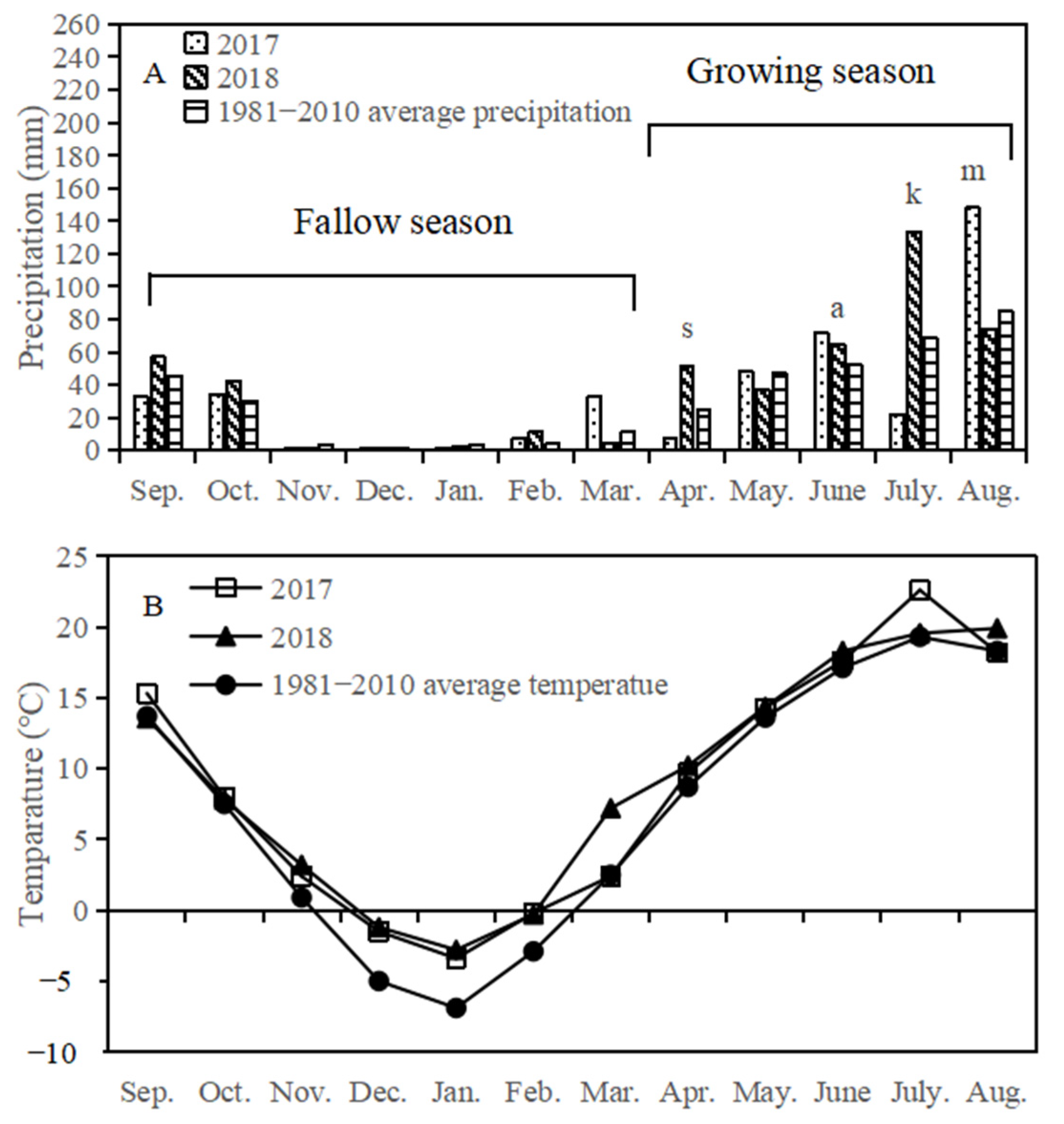
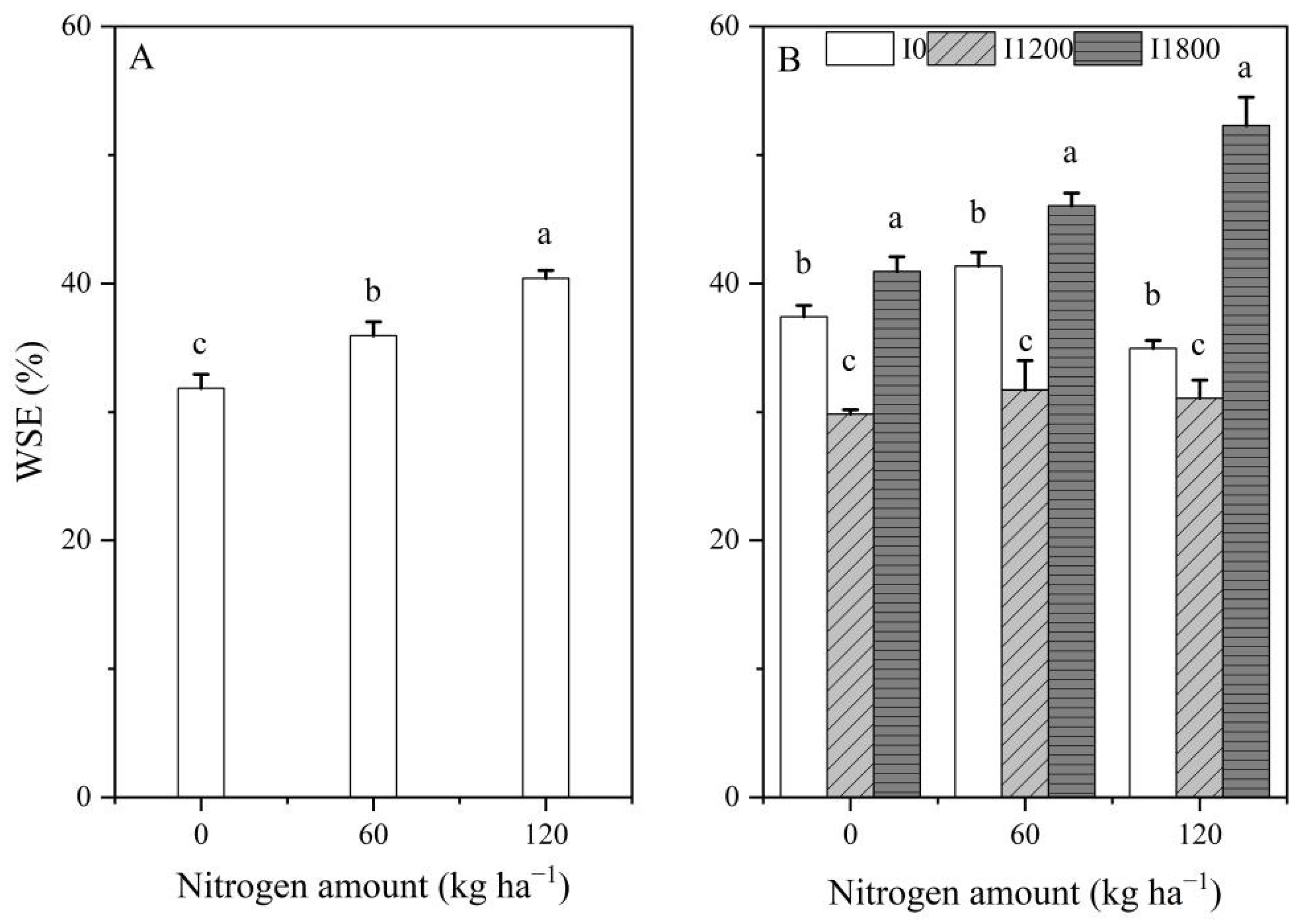

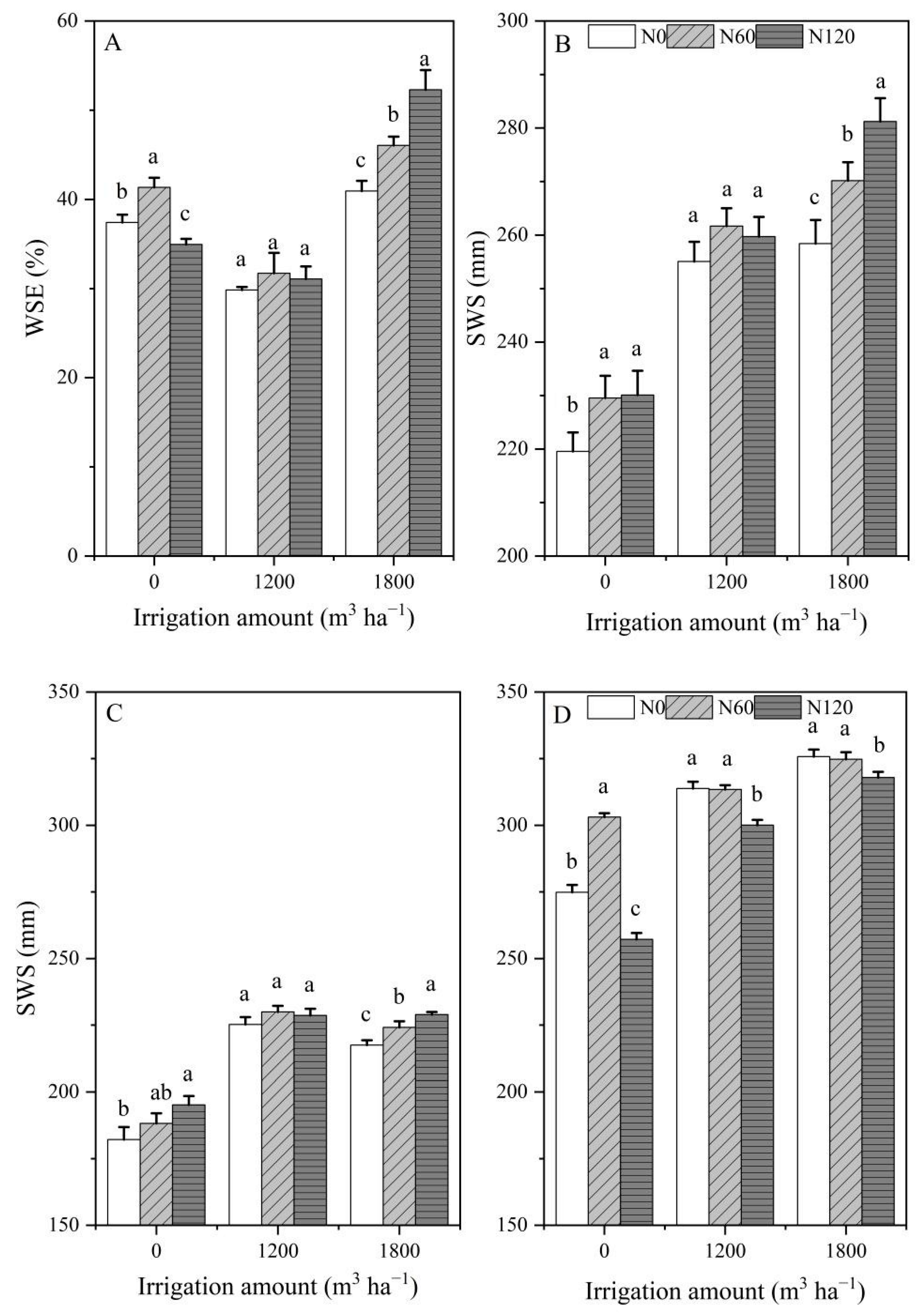
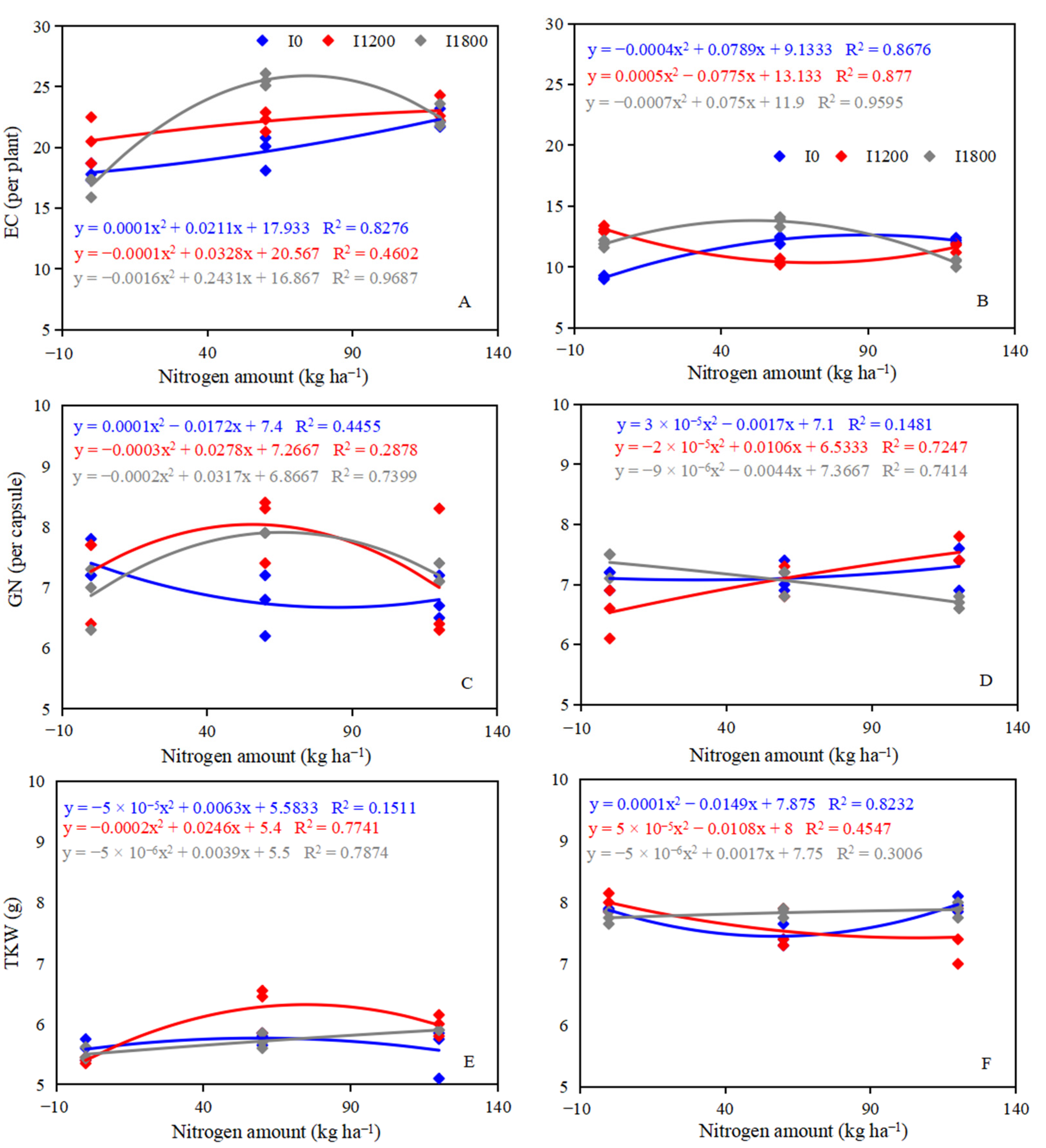
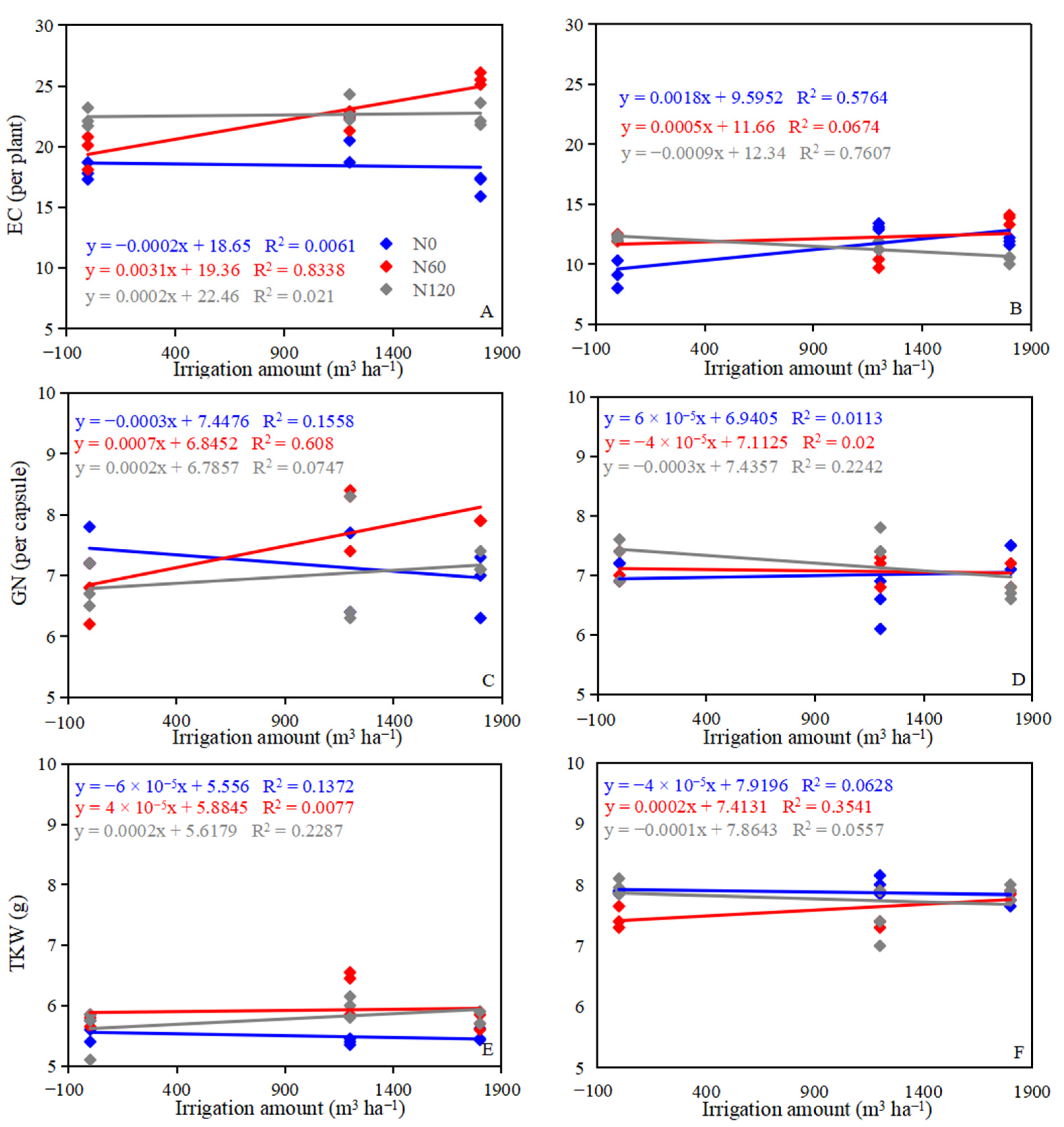

| Irrigation (I) | Nitrogen (N) | Year | I × N | I × Y | N × Y | I × N× Y | ||
|---|---|---|---|---|---|---|---|---|
| df | 2 | 2 | 1 | 4 | 2 | 2 | 4 | |
| Yield components | Grain yield (kg ha−1) | *** | ** | * | * | ns | ns | ns |
| Biomass (kg ha−1) | * | ** | ns | ns | ns | ns | ns | |
| Effective capsule number (per plant) | * | * | * | ** | * | ns | ns | |
| Grain number (per capsule) | ** | * | * | * | ns | ns | ns | |
| Thousand kernel weight (g) | ns | ns | ns | ns | ns | ns | ns | |
| Water utilization | Water consumption (mm) | ** | ns | ns | * | ns | ns | ns |
| Water-use efficiency (kg ha−1 mm−1) | ** | ** | ** | ** | ** | ** | ** | |
| Irrigation water-use efficiency (kg ha−1 mm−1) | ** | ns | * | * | ns | ns | ns | |
| N utilization | Agronomy N use efficiency (%) | ns | ** | * | * | ns | * | ns |
| N partial factor productivity (kg hg−1) | ns | ** | ns | * | ns | * | ns |
| Treatments | 2017 | 2018 | |||||||
|---|---|---|---|---|---|---|---|---|---|
| GY (kg ha−1) * | Changes (%) | Bio (kg ha−1) | Changes (%) | GY (kg ha−1) | Changes (%) | Bio (kg ha−1) | Changes (%) | ||
| Irrigation | I0 | 1048.30 b | – | 2336.99 b,** | – | 1070.22 c | – | 2634.67 b | – |
| I1200 | 1410.32 a | 34.53% | 2776.85 a | 18.82% | 1135.56 b | 6.11% | 2931.69 ab | 11.27% | |
| I1800 | 1501.97 a | 6.50% | 2920.72 a | 5.18% | 1212.33 a | 6.76% | 3121.95 a | 6.49% | |
| Increase in percentage from I0 to I1800 | 43.28% | 24.98% | 13.28% | 18.49% | |||||
| Nitrogen | N0 | 1225.89 b | – | 2198.81 b | – | 1094.67 b | – | 2487.59 c | – |
| N60 | 1325.55 ab | 8.13% | 3032.67 a | 37.92% | 1172.33 a | 7.09% | 3275.31 a | 31.67% | |
| N120 | 1409.15 a | 6.31% | 2803.09 a | −7.57% | 1151.11 a | −1.81% | 2925.41 b | −10.68% | |
| Increase in percentage from N0 to N120 | 14.95% | 27.48% | 5.16% | 17.60% | |||||
| Treatments | 2017 | 2018 | ||||||
|---|---|---|---|---|---|---|---|---|
| EC (×105 ha−1) * | GN (No.) | TKW (g) | GY (kg ha−1) | EC (×105 ha−1) | GN (No.) | TKW (g) | GY (kg ha−1) | |
| I0N0 | 143.47 g,** | 7.40 b | 5.58 bcd | 913.79 g | 146.13 g | 7.10 ab | 7.88 ab | 1044.00 e |
| I0N60 | 167.17 f | 6.73 c | 5.77 bcd | 1006.50 f | 208.53 f | 7.10 ab | 7.45 c | 1069.67 de |
| I0N120 | 212.17 e | 6.80 c | 5.57 cd | 1224.61 e | 231.80 e | 7.30 a | 7.97 a | 1097.00 d |
| I1200N0 | 218.01 e | 7.27 bc | 5.40 d | 1339.17 d | 278.43 c | 6.53 c | 8.00 a | 1087.67 de |
| I1200N60 | 261.57 d | 8.03 a | 6.28 a | 1424.71 c | 246.23 d | 7.10 ab | 7.53 bc | 1165.67 bc |
| I1200N120 | 287.92 c | 7.00 bc | 5.98 ab | 1467.07 bc | 290.c | 7.53 a | 7.43 c | 1153.33 c |
| I1800N0 | 219.27 e | 6.87 c | 5.50 cd | 1424.71 c | 309.40 b | 7.37 a | 7.75 abc | 1152.33 c |
| I1800N60 | 340.04 a | 7.90 a | 5.72 bcd | 1545.42 a | 366.19 a | 7.07 ab | 7.83 abc | 1281.67 a |
| I1800N120 | 312.75 b | 7.20 bc | 5.83 bc | 1535.77 ab | 288.19 c | 6.70 bc | 7.88 ab | 1203.00 b |
| Treatments | 2017 | 2018 | ||||||||
|---|---|---|---|---|---|---|---|---|---|---|
| ET * | WUE | WUEI | ANUE | NPFP | ET | WUE | IWUE | NAUE | NPFP | |
| (mm) | (kg ha−1 mm−1) | (kg ha−1 mm−1) | (kg ha−1) | (kg ha−1) | (mm) | (kg ha−1 mm−1) | (kg ha−1 mm−1) | (kg ha−1) | (kg ha−1) | |
| I0N0 | 358.12 d,** | 2.55 e | – | – | – | 305.59 g | 3.42 b | – | – | – |
| I0N60 | 352.05 d | 2.86 d | – | 1.55 c | 16.78 c | 287.39 h | 3.72 a | – | 0.43 c | 17.83 c |
| I0N120 | 345.12 e | 3.55 a | – | 2.59 a | 10.21 e | 333.79 f | 3.29 c | – | 0.44 c | 9.14 e |
| I1200N0 | 435.03 c | 3.08 c | 11.16 b | – | – | 422.18 e | 2.58 e | 9.07 b | – | – |
| I1200N60 | 430.31 c | 3.31 b | 11.87 a | 1.43 cd | 23.75 b | 429.12 e | 2.71 d | 9.71 a | 1.30 b | 19.43 b |
| I1200N120 | 431.64 c | 3.40 ab | 12.23 a | 1.07 de | 12.23 d | 440.54 d | 2.62 de | 9.61 a | 0.55 c | 9.61 d |
| I1800N0 | 502.79 a | 2.83 d | 7.91 c | – | – | 473.53 c | 2.45 f | 6.40 d | – | – |
| I1800N60 | 496.14 b | 3.11 c | 8.58 c | 2.01 b | 25.76 a | 486.30 b | 2.64 de | 7.12 c | 2.16 a | 21.36 a |
| I1800N120 | 491.34 b | 3.12 c | 8.53 c | 0.93 e | 12.80 d | 504.21 a | 2.38 f | 6.68 d | 0.42 c | 10.03 d |
| Year | Organic Matter (g kg−1) | Total N (g N kg−1) | Total P (mg P kg−1) | Alkali-Hydrolyzable N (mg N kg−1) | Available P (mg P kg−1) | Available K (mg K kg−1) | pH |
|---|---|---|---|---|---|---|---|
| 2017 | 10.51 | 1.00 | 0.85 | 47.91 | 26.43 | 108.3 | 8.1 |
| 2018 | 10.12 | 0.81 | 0.69 | 49.37 | 27.24 | 108.42 | 8.1 |
| Sub-Factor: Nitrogen (N) | Main Factor: Irrigation (I) | |||
|---|---|---|---|---|
| N|I | I0 (0 m3 ha−1) | I1200 (1200 m3 ha−1) | I1800 (1800 m3 ha−1) | |
| N0 (0 kg ha−1) | I0N0 | I1200N0 | I1800N0 | |
| N60 (60 kg ha−1) | I0N60 | I1200N60 | I1800N60 | |
| N120 (120 kg ha−1) | I0N120 | I1200N120 | I1800N120 | |
Disclaimer/Publisher’s Note: The statements, opinions and data contained in all publications are solely those of the individual author(s) and contributor(s) and not of MDPI and/or the editor(s). MDPI and/or the editor(s) disclaim responsibility for any injury to people or property resulting from any ideas, methods, instructions or products referred to in the content. |
© 2022 by the authors. Licensee MDPI, Basel, Switzerland. This article is an open access article distributed under the terms and conditions of the Creative Commons Attribution (CC BY) license (https://creativecommons.org/licenses/by/4.0/).
Share and Cite
Cui, Z.; Effah, Z.; Yan, B.; Gao, Y.; Wu, B.; Wang, Y.; Xu, P.; Wang, H.; Zhao, B.; Wang, Y. Water and Nitrogen Coupling Increased the Water-Nitrogen Use Efficiency of Oilseed Flax. Plants 2023, 12, 51. https://doi.org/10.3390/plants12010051
Cui Z, Effah Z, Yan B, Gao Y, Wu B, Wang Y, Xu P, Wang H, Zhao B, Wang Y. Water and Nitrogen Coupling Increased the Water-Nitrogen Use Efficiency of Oilseed Flax. Plants. 2023; 12(1):51. https://doi.org/10.3390/plants12010051
Chicago/Turabian StyleCui, Zhengjun, Zechariah Effah, Bin Yan, Yuhong Gao, Bing Wu, Yifan Wang, Peng Xu, Haidi Wang, Bangqing Zhao, and Yingze Wang. 2023. "Water and Nitrogen Coupling Increased the Water-Nitrogen Use Efficiency of Oilseed Flax" Plants 12, no. 1: 51. https://doi.org/10.3390/plants12010051






